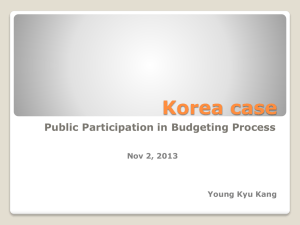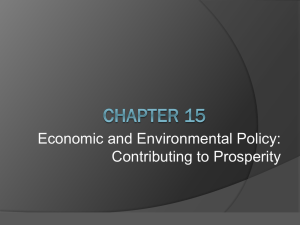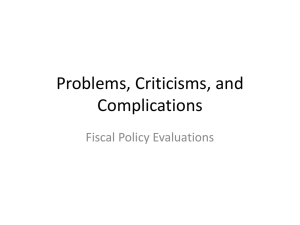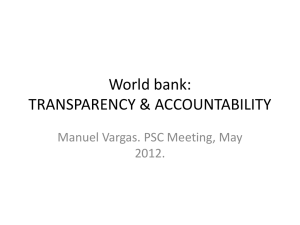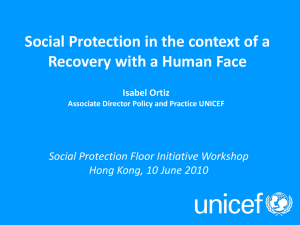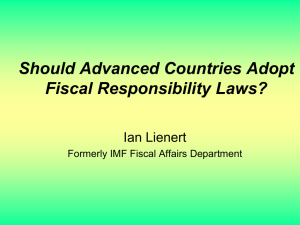Objectives of Fiscal Responsibility Laws (FRLs)
advertisement
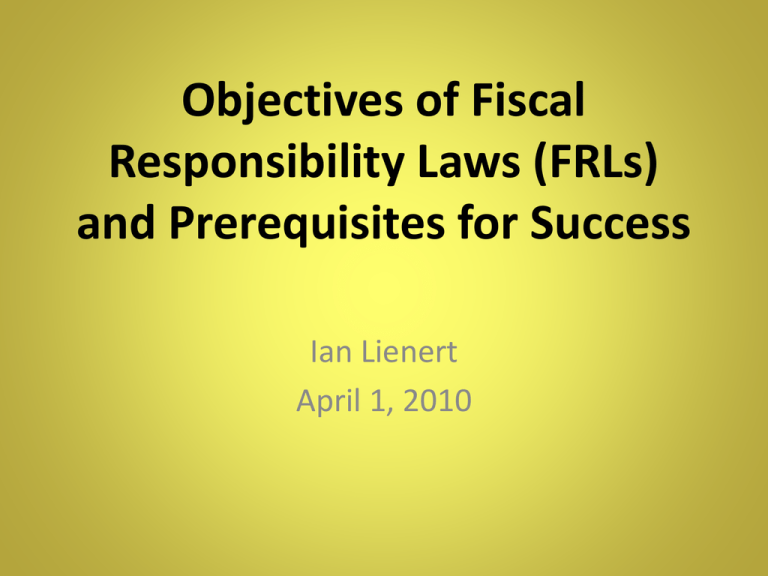
Objectives of Fiscal Responsibility Laws (FRLs) and Prerequisites for Success Ian Lienert April 1, 2010 Three Main Objectives of FRLs 1. Fiscal stability (long-term debt sustainability and short-term fiscal stability and fiscal rules) 2. Transparency (of the governments fiscal policy intentions, as well as reports on budget execution) 3.Accountability (collective responsibility of the government to parliament; not individual accountability within the government) 1. Fiscal Stability—1 1. Medium-term macro-fiscal stability and annual budget objectives or targets. A FRL may require: a. Objectives for key fiscal aggregates (e.g., “reduce debt to a prudent level”). b. “Fiscal rules” – numerical targets. The most common fiscal objectives/rules pertain to gross debt, the fiscal balance (perhaps defined “over the cycle”), and aggregate expenditures 1. Fiscal Stability—2 2. Reasonable stability in tax policies (tax/duty rates and tax bases). 3. Long-term fiscal sustainability and debt analysis. Government debt and fiscal balances interact: medium- and long-term debt sustainability analysis and scenarios are needed. 4. Need procedures for parliamentary “buy-in”. Clarification of parliament’s budget amendment powers; executive’s power to not fully spend approved budget; contingency reserves (usually not part of a FRL, but other laws). 2. Transparency: of future Fiscal Policy—1 The FRL may require in annual budget documents: 1. A statement of fiscal policy strategy or intentions over a medium-term period. This would be supported by: Baseline medium-term fiscal projections, based on unchanged policies, which identifies available fiscal space for new policies. The impact in the annual budget (and in medium term) of new revenue and expenditure policies to be adopted in the upcoming budget . 2. Transparency: of future Fiscal Policy—2 The FRL may also require the following in annual budget documents: 2. An annual budget policy strategy (BPS) explaining how the BPS helps to achieve the MT fiscal policy objectives. 3. Explanations of why the government—even a newly elected one—is deviating from the previous (government’s) fiscal intentions. 4. Long-term scenarios of fiscal balances e.g., for the impact of changing demographics or climate change. 5. A statement of the main fiscal risks as part of annual budget documentation. 3. Accountability to Parliament and Public (transparency of recent past fiscal developments) By the executive: • In-year fiscal outcomes relative to budgets: monthly/quarterly. • Six-monthly formal review of budget outcomes, which may lead to a pre-budget debate in Parliament. • Annual budget performance reports and financial statements. • Report on how the government has followed up on the external auditor’s report External Audit: • Annual report to parliament on budget performance. Includes certification of annual accounts (financial statements) by the external auditor. FRLs from around the world Country 1 2 3 4 5 6 Australia, 1998 New Zealand, 1994 United Kingdom, 1998 Main Objectives Secondary Aims Fiscal Stability: Fiscal lower deficits or Transparency run surpluses; reduce debt Fiscal stability and fiscal transparency Hungary, 2008 Brazil, 2000 Argentina, 1999, 2001, 2004 Fiscal stability Transparency 7 Colombia, 1997, 2001, (targets for 2003 8 Ecuador , 2002, 2005 spending, deficits and/or debt) 9 Panama, 2002 Focus on targets. 10 India, Pakistan, Sri Transparency Lanka, 2003, 05 Success? Yes Yes Yes ?? Yes No No No No Mixed Prerequisites for Success of a Fiscal Responsibility Law (FRL) Messages 1. Get “Basics” Right First 2. Examine what can be done without a FRL 3. Seek buy-in from parliament and the public 1. Get “Basics” Right First • Good annual budget preparation (realistic projections for macro variables, budget revenues; top-down spending ceilings; costing of new policies; clear presentation of budget: objectives, targets, priorities, risks……) • Controlled budget execution (firm spending controls; adequate internal audit; no payment arrears) • Strong cash management (central control over government bank accounts; cash flow forecasts). • Timely and accurate accounts (monthly/quarterly fiscal reports; audited annual accounts). • External oversight and evaluation (by external auditor, parliamentary committees, anti-corruption agency) 2. Examine what can be done without a FRL? By the executive: • Improve budget formulation & presentation, execution, cash management, fiscal reporting and accounting. • Practice fiscal discipline; don’t tolerate “creative accounting”; sanction misuse of funds. • Modify Financial Regulations or propose amendments to the Public Finance (System) Law. By parliament : • Amend its internal regulations to improve budget adoption procedures and its internal organization arrangements. 3. Obtain buy-in by politicians and the public International experience with FRLs: the laws themselves do not buy credibility. Buy-in is needed at three levels: 1. Within the Government: Is a top-down spending process “bought” by the President, other Ministers of the Cabinet? 2. At Parliament: What procedures are in place to constrain parliament’s understandable constituency concerns? What happens when shortfalls in revenue or grant support occur? Should debt rise to finance shortfalls? 3. With the Public and Civil Society: Public hearings/consultations increase chances of FRL’s successful adoption and implementation.

